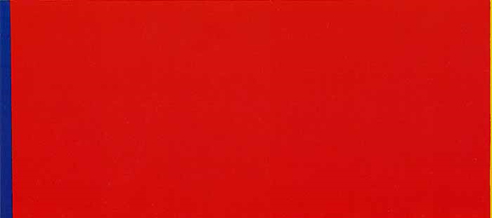In “When Art Has No Answers,” Vee Fidati introduces readers to “Who’s Afraid of Red, Yellow and Blue III, a piece by artist Barnett Newman. Through this seemingly straightforward painting, the artist prompts questions about how the general public views art. Fidati furthers these same questions, all while offering valuable historical and cultural context, as well as their own insights. –Susanna Strauss ‘23, editorial assistant
When Art Has No Answers
Vee Fidati ’25
In 1967, American artist Barnett Newman created a painting that depicted nothing. It was a massive work, eighteen feet wide and eight feet tall, large enough to take up an entire museum wall. The piece, entitled Who’s Afraid of Red, Yellow and Blue III, was almost completely red, bookended by a thin vertical stripe of blue on one side and a virtually invisible yellow stripe on the other. There were no images to interpret, no figures to identify, and nothing that resembled an everyday object or occurrence, only three disproportionate swaths of color. From the outset, public reaction to this painting was intensely critical due to its disarming simplicity, the backlash against it eventually culminating in the work being irreparably damaged by an angry patron of the Stedelijk Museum. Newman’s work thus became the latest victim of the Western world’s ever-present crusade against modern art. This should come as no surprise: as Susan Sontag insinuates in her essay “Against Interpretation,” the contemporary manner in which we are taught to experience art lends itself to an obsession with interpretation–an endless need to decode, deconstruct, and derive meaning. When people find themselves faced with art that resists interpretation, they tend to feel intellectually threatened, an attitude which often leads to the dismissal, condemnation, or even blatant destruction of art that is deemed to be uncomplex, as was the case with Who’s Afraid of Red, Yellow and Blue III.

For many people in the modern Western world, the word “art” conjures images of detailed representational paintings or sculptures that depict religious and political themes, often with layers of symbolism and references to mythology. Art should take the artist years to master, it is believed, and should have a core message – hidden, but not too hidden – for the intellectual to decipher and ponder. There is constant public pressure for art to have a function, to have something to say. Who’s Afraid of Red, Yellow and Blue III, though, with its abrasive color and overwhelming lack of detail, exemplifies what Susan Sontag calls “the flight from interpretation,” a phenomenon in which artists attempt to create art that cannot be interpreted at all, forcing viewers to simply perceive its form rather than its content (7). “Abstract painting,” Sontag comments, “is the attempt to have, in the ordinary sense, no content; since there is no content, there can be no interpretation” (7). The lack of interpretability in Barnett Newman’s art challenges viewers to change the way they perceive creative works, though some audiences inevitably end up concluding that the revolutionary directness of Newman’s paintings is absurd or pretentious, a sort of insertion of content, and a type of interpretation, in and of itself.
While Who’s Afraid of Red, Yellow and Blue III is a content-less painting by Sontag’s definition, it is in no way a meaningless or worthless painting, though critics have certainly described it in this vein. Even though little information can be gleaned from the work itself, the art historical context of Who’s Afraid of Red, Yellow and Blue III allows the act of interpretation to persist on a different level. When considered within its historical context, this work can be read as a reaction to the horrific events of World War II. Newman, a Jewish artist, was one of the many creatives who viewed abstract expressionism as a way to represent the hopelessness of the era.

The only way for art to progress after the Holocaust was for it to first devolve into its basic principles: simple shapes and primary colors. In this way, the context of the painting creates its meaning; the nothingness of Newman’s art is a respectful nothingness, a moment of silence after a great tragedy. However, when we see interpretation as the primary goal of interacting with art, it is impossible to grasp the gravity of Newman’s work, since it is essentially and purposefully uninterpretable, and by extension, untamable. As Sontag insightfully asserts, “Real art has the capacity to make us nervous. By reducing the work of art to its content and then interpreting that, one tames the work of art” (5). With this statement, Sontag argues that interpretation often functions as a crutch, helping audiences avoid acknowledgment of the raw emotions a work might evoke. Without a clear message, art is overwhelming, and without the mental capacity to allow art to overwhelm, we subject “content-less” art to ridicule and violence.
Although Who’s Afraid of Red, Yellow and Blue is a series of four paintings (differentiated in name by the roman numerals I through IV), the third installation distinguishes itself from its counterparts with its sordid history. It’s worth displaying the entire series here so that the reader can take in the full impact of these works, especially the third piece, with which this essay is primarily concerned:



From the beginning of its time in the public view, Who’s Afraid of Red, Yellow and Blue III galvanized multiple individuals into sending letters to the Stedelijk Museum decrying the painting, questioning why anyone would consider it art, and even claiming that it made them sick or uneasy. Unfortunately, these letters were the tamest form of criticism the work received. In 1986, a man slashed Who’s Afraid of Red, Yellow and Blue III with a box cutter several times. The cuts spanned almost the entire length of the canvas, and though it has since been restored, the quality of the paint used to restore it was significantly poorer than the original, meaning that the painting can never truly regain its previous power. The destruction of Who’s Afraid of Red, Yellow and Blue III proves that many individuals are not equipped with the ability to interact with art that is functionally uninterpretable. Even though the painting was vandalized in rage at it not being “real art,” the man who attacked it was allowing the work to make him feel something, circuitously proving its validity as an expressive piece. However, in order to avoid the future destruction of similar creations, we must become more open to experiencing art without relying on interpretation. Susan Sontag demands the development of a new vocabulary for discussing art, one that is “descriptive, rather than prescriptive” (8). In other words, the art experience needs to be less centralized on deciphering the meaning of a piece and more focused on examining the connection that develops between the viewer and the artwork. Once we stop trying to translate art, we can forge a more intimate relationship with it and allow it to instill emotion in us, whether that emotion is pleasure, revulsion, fear, or something entirely different.
Susan Sontag’s argument in “Against Interpretation” holds up in the current landscape of modern art. Western audiences in particular are too focused on content and meaning and will rarely allow themselves to interact with a work of art without trying to extract a statement or message from it. If we do not develop a better vocabulary for talking about works of art, the condemnation and destruction of pieces like Who’s Afraid of Red, Yellow and Blue III will continue. As of now, Who’s Afraid of Red, Yellow and Blue III cannot be put on display, both because it has not yet been properly restored and because displaying it again could subject it to further attacks. The reactive tendencies of those committed to finding answers in art leads to restrictive definitions about what constitutes true art, and in the most extreme cases, results in the labeling of some works as “degenerate,” a popular term used by the Nazis to disparage the abstract. The idea that art must be interpretable has actively harmed the art world to the point where museums fear for the safety of works that are controversial due to their perceived lack of content – that is, lack of immediate answers. “What is important now is to recover our senses,” Sontag instructs. “We must learn to see more, to hear more, to feel more” (10). For the sake of moving past this era of violence, Western society needs to broaden its definition of what constitutes “real art” in order to experience works for their form and their emotional value, rather than for their academic interpretations.
Works Cited
99pi. “The Many Deaths of a Painting.” 99% Invisible, 1 Jan. 1970, https://99percentinvisible.org/episode/the-many-deaths-of-a-painting/.
“Abstract Expressionism: Exhibition: Royal Academy of Arts.” Exhibition | Royal Academy of Arts, https://www.royalacademy.org.uk/exhibition/abstract-expressionism.
“Barnett Newman.” Stedelijk Museum Amsterdam, https://www.stedelijk.nl/en/exhibitions/63824.
Sontag, Susan. “Against Interpretation.” Against Interpretation, Picador, 1966, pp. 1-10.
“Who’s Afraid of Red, Yellow and Blue.” Wikipedia, Wikimedia Foundation, 30 Mar. 2021, https://en.wikipedia.org/wiki/Who’s_Afraid_of_Red,_Yellow_and_Blue.
Recent Comments